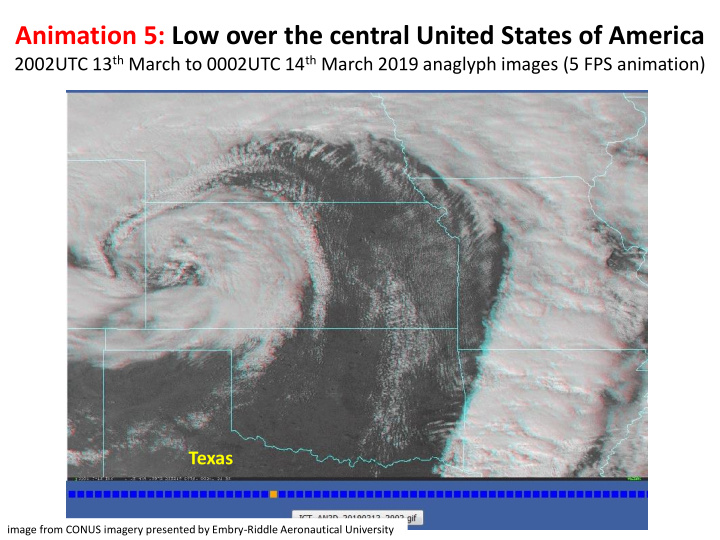



Animation 5: Low over the central United States of America 2002UTC 13 th March to 0002UTC 14 th March 2019 anaglyph images (5 FPS animation) Texas image from CONUS imagery presented by Embry-Riddle Aeronautical University
Animation 6: Superposition of RADAR and surface observations on 3D anaglyph satellite data (5 FPS animation) Texas Socrative question 5 image from CONUS imagery presented by Embry-Riddle Aeronautical University
Socrative question 5: How well do the anaglyph 3D satellite, RADAR and surface observations render the 3D stereo effect? A. The superposition of the observational data enhances the 3D stereo effect B. The superposition of the observational data substantially reduces the 3D stereo effect. C. There is no difference between the two animations. D. I cannot see the 3D stereo effect in either animation REFERENCE
Some additional anaglyph 3D case studies for you to examine with your anaglyph glasses http://www.virtuallab.bom.gov.au/eve nts/aomsuc-training/aomsuc-10- training-event-presentations-and- resources/
Various ways of presenting 3D stereo satellite imagery 1: "3D Wiggle" animation 2: Stereo pair images (cross eyed viewing method) Anaglyph glasses 4: 2 panel image animation played on Smartphone 3: "Anaglyph"animation and rendered in a viewer (requiring viewing glasses) (eg. Google Cardboard).
image from Google Earth Method 4 analogy: Virtual Reality exercise image from Viri Virtual Reality Melbourne facebook post
anaglyph images from CONUS imagery presented by Embry-Riddle Aeronautical University Advantages in using 3D stereo satellite imagery Analysing vertical motion of Analysing multilayer Analysing the interaction developing thunderstorms cloud, superior AMV's between low and upper levels of the atmosphere Detection of minor variations Analysing atmospheric Better monitor low cloud in height for oceanic cellular shear and trends in these below broken higher cloud convection Non-anaglyph images from CIMSS Satellite Blog, case studies produced by Scott Lindstrom SSEC
Suggested use of 3D stereo satellite imagery within a meteorological forecasting / training centre Selective use by severe weather forecasters to gain greater insight into a difficult situation Enhanced teaching of meteorological principles to Normal animation and Wiggle 3D animation in two panel display Trainee Meteorologists
Summary • The constellation of geostationary satellites over our region • Utilising limb effects for enhanced forecaster monitoring • Introducing the 3D stereo satellite imagery utilising Himawari-8, Geo-KOMPSAT 2A, GOES-16 and 17 data
Recommend
More recommend